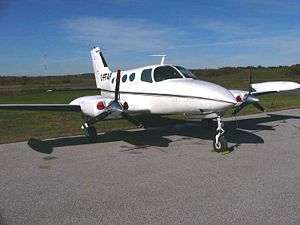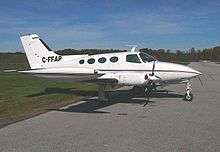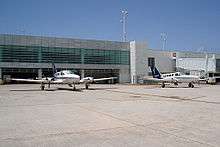Cessna 402
| Cessna 401 & 402 | |
|---|---|
 | |
| 1967 model Cessna 402 | |
| Role | Corporate transport and airliner |
| National origin | United States |
| Manufacturer | Cessna |
| First flight | 26 August 1965 |
| Introduction | 1967 |
| Primary user | Cape Air |
| Produced | 1966–1985 |
| Developed from | Cessna 411[1] |
The Cessna 401 and 402 are series of 6 to 10 seat, light twin, piston engine aircraft. This line was manufactured by Cessna from 1966 to 1985 under the name Utiliner and Businessliner.[1][2] All seats are easily removable so that the aircraft can be used in an all-cargo configuration.[1] Neither the Cessna 401 nor the 402 were pressurized, nor were they particularly fast for the installed horsepower. Instead, Cessna intended them to be inexpensive to purchase and operate.[2]
Development
The Cessna 401 and 402 were developments of the Cessna 411.[1] All 401s and 402s are powered by 300 hp (224 kW) turbocharged Continental engines with three-bladed, constant speed, fully feathering propellers. On later models cruise power was limited to 75% to reduce cabin noise. Some aircraft have a propeller synchrophaser to reduce cabin noise and vibration.[1]
The Cessna 401s, 402s, 402As and some 402Bs built from 1966 to 1971 had four small oval windows, which gave the aircraft a similar appearance to the pressurized Cessna 340. Starting halfway through the production of the Cessna 402B the window configuration was changed to the more distinctive five rectangular windows, an arrangement that was retained through the 402C model, until the completion of production in 1987. All 402Bs were equipped with tip-tanks.[2]
Modifications
In 1969, American Jet Industries began work on a turboprop-powered conversion of the Cessna 402, named the Turbo Star 402, using Allison 250-B17 engines.[3] The prototype flew on 10 June 1970.[3] Further modifications providing increased fuel tankage, higher gross weight, and lower minimum control speed were carried out in 1974 and the modification was recertificated.[3] Scenic Airlines of Las Vegas purchased the rights to the design in 1977.[4]
The Cessna 402C may be outfitted with vortex generators to increase maximum allowable takeoff weight to 7,210 lb (3,270 kg), with a zero-fuel weight of 6,750 lb (3,062 kg).[5]
Another modification for the 402C increases the maximum landing weight to 7,200 lb (3,266 kg), which allows commercial operators to fly with an increased payload on shorter routes.[6]
Variants

This family of aircraft was built in several versions:
- 401
- Six to eight seat interior, intended for corporate transport. Produced 1966-1972. 404 were built. The replacement for the 401 in the corporate transport role was the 402 Businessliner variant. Certified 20 September 1966.[1][7][8]
- 401A
- A 401 with minor changes, 132 built. Certified 29 October 1968.[8][9]
- 401B
- A 401A with minor changes, 91 built later replaced by the 402B. Certified 12 November 1969.[8][9]
- 402
- A 401 with either a utility (for freight) or nine-seat commuter use, number built included in 401 totals. Certified 20 September 1966.[8][9]
- 402A
- A 402 with a baggage compartment in lengthened nose and an optional crew entry door, 129 built. Certified 3 January 1969.[8][9]
- 402B Utiliner/Businessliner
- 402A with minor changes, from 1972 had increased cabin volume and five windows each side, 129 built. Certified 12 November 1969.[8][9]
- 402C Utiliner/Businessliner
- 402B with 325 hp engines, increased takeoff weight, longer wingspan without main tip tanks and hydraulic instead of electric landing gear, 681 built. Certified 25 September 1978.[8][9]
1535 Cessna 402s were built.[7]
Operators

Civilian
The Cessna 402 has proven to be very dependable over the years, which, along with its range and passenger capacity, has made it a popular choice for many small regional airlines worldwide. The aircraft are generally flown on short, thin routes to hubs where passengers can connect to higher density routes.
The largest operator of the type is Cape Air, which as of March 2015 has a fleet of over 83 Cessna 402s operating in the Caribbean and United States.[10]
Military

- Finnish Air Force two aircraft,[13] former operator
- Royal Malaysian Air Force,[15] former operator since 2010
Accident
American R&B singer Aaliyah died along with the pilot and seven others, including makeup artists and record label executives, when the Cessna 402B they were flying on, registered N8097W, crashed after takeoff on August 25, 2001 in Marsh Harbour, Abaco Islands, The Bahamas. The main cause of the crash was determined to be loading the plane beyond its maximum takeoff weight.[17] Additionally, the pilot, Luis Morales III, was unlicensed at the time of the accident and had traces of cocaine and alcohol in his system.[18][19] Aaliyah's family later filed a wrongful death lawsuit against Blackhawk International Airways, which was settled out of court.[20]
Specifications (402C)
Data from Plane & Pilot, Airliners.net, The Incomplete Guide to Airfoil Usage
General characteristics
- Crew: One or two
- Capacity: Up to 9 passengers depending on configuration
- Length: 36 ft 5 in (11.09 m)
- Wingspan: 44 ft 2 in (13.45 m)
- Height: 11 ft 6 in (3.49 m)
- Wing area: 225.8 sq ft (21.0 m²)
- Airfoil: NACA 23018 (root) NACA 23015 (tip)
- Empty weight: 4,069 lb (1,845 kg)
- Useful load: 2781 lb (1262 kg)
- Loaded weight: 6,865 lb (3,114 kg)
- Max. takeoff weight: 6,850 lb (3,107 kg)
- Powerplant: 2 × Continental TSIO-520-VB turbocharged, fuel-injected piston engines, 325 hp (240 kW) each
Performance
- Never exceed speed: 230 kn (266 mph, 428 km/h)
- Maximum speed: 230 kn (266 mph, 428 km/h)
- Stall speed: 71 kn (82 mph, 132 km/h)
- Range: 1,273 nmi (1,467 mi, 2,360 km)
- Service ceiling: 26,900 ft (8,200 m)
- Rate of climb: 1,450 ft/min (7,36 m/s)
- Wing loading: 30.3 lb/(sq ft) (148 kg/m²)
- Power/mass: 10.5 lb/hp (0.15 kW/kg)
See also
- Aircraft of comparable role, configuration and era
- Related lists
References
Notes
- 1 2 3 4 5 6 7 8 Plane and Pilot: 1978 Aircraft Directory, page 92. Werner & Werner Corp, Santa Monica CA, 1977. ISBN 0-918312-00-0
- 1 2 3 Montgomery, MR & Gerald Foster: A Field Guide to Airplanes, Second Edition, page 108. Houghton Mifflin Company, 1992. ISBN 0-395-62888-1
- 1 2 3 Jane's All the World's Aircraft 1977–78, p.398
- ↑ Taylor 1989, p. 793
- ↑ Cessna 402C MICRO Vortex Generator Kit
- ↑ APE XL for 402C
- 1 2 Demand Media, Inc (2008). "The Cessna 411, 401 & 402". Retrieved 2008-08-09.
- 1 2 3 4 5 6 7 Federal Aviation Administration (March 2007). "TYPE CERTIFICATE DATA SHEET NO. A7CE". Retrieved 2008-08-10.
- 1 2 3 4 5 6 Simpson 1991, page 108
- ↑ Cape Air (2014). "Our Story". Retrieved 16 March 2015.
- 1 2 Siegrist 1987, p. 176.
- ↑ Wheeler 1980, p. 1330.
- ↑ Wheeler 1980, p. 1337.
- ↑ Wheeler 1980, p. 1344.
- ↑ Wheeler 1980, p. 1357.
- ↑ Gaines 1982, p. 1387.
- ↑ NTSB (2001-08-25). "NTSB Identification: MIA01RA225". Retrieved 2007-09-26.
- ↑ Schumacher-Rasmussen, Eric. "Pilot Of Aaliyah's Plane Had Been Caught With Cocaine, Was Not Authorized To Fly: Luis Morales' pilot's license should have been revoked under FAA rules". MTV.com, August 29, 2001. Retrieved 21 September 2013.
- ↑ Schumacher-Rasmussen, Eric. "Aaliyah Killed In Plane Crash". MTV.com, August 26, 2001. Retrieved 21 September 2013.
- ↑ Silverman, Stephen M. "Aaliyah's Parents Settle Crash Lawsuit". People. Retrieved 27 March 2014.
Bibliography
- Gaines, Mike (6 November 1982). "World's Air Forces 1982". Flight International. Vol. 122 no. 3835. pp. 1327–1388.
- Jane's All the World's Aircraft 1977–78. London: Jane's Yearbooks.
- Siegrist, Martin (October 1987). "Bolivian Air Power — 70 Years On". Air International. Vol. 33 no. 4. pp. 170–176, 194. ISSN 0306-5634.
- Simpson, R.W. (1991). Airlife's General Aviation. England: Airlife Publishing. ISBN 1-85310-194-X.
- Taylor, Michael J. H. (1989). Jane's Encyclopedia of Aviation. London: Studio Editions.
- Wheeler, Barry C. (4 October 1980). "World's Air Forces 1980". Flight International. Vol. 118 no. 3726. pp. 1323–1378. ISSN 0015-3710.
External links
| Wikimedia Commons has media related to Cessna 402. |